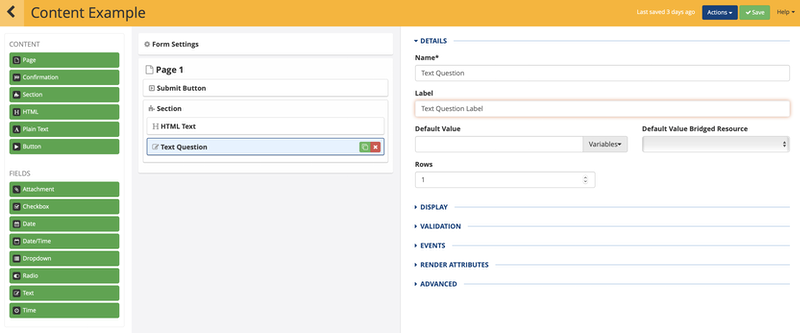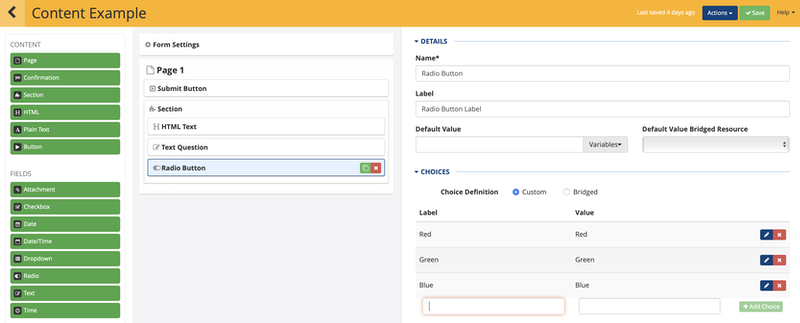Adding Questions to Forms
Introduction
Questions are the main reasons for any Form.
Goals
The goals for the article are:
- Learn the different types of questions available
- Be familiar with default and required values
- Become more familiar with the builder
Questions
Questions are the central piece of any Form. They collect up information from the customer, and use that information to drive business processes.
Common Elements
Questions have a lot of common elements. They each require a name (how the application refers to them), and most of them have an option for a Label (what you show the customer). All of the List questions have similar options for hard-coded list elements.
There are similar options from Display through Advanced on questions. These options are covered in a separate article.
Text
Text questions are meant to collect any type of character based data from names to descriptions.

- Name - required field. Only letters, numbers, spaces, and hyphens allowed. Unique reference used by the application.
- Label - name displayed to the customer completing the form.
- Default Value - set to any static text.
- Default Value Bridged Resource - option to select a Bridged Resource for the question to set a default value
- Rows - sets the height of the field. Default is 1.
List Style
There are three list style questions, Radio, Dropdown, and Checkbox. Each treats a list slightly differently, but they are similar in presentation in the builder.
Here is a Radio question in the builder:

- Name - required field. Only letters, numbers, spaces, and hyphens allowed. Unique reference used by the application.
- Label - name displayed to the customer completing the form.
- Default Value - set to any static text.
- Default Value Bridged Resource - option to select a Bridged Resource for the question
- Choices - when set to Custom, you determine the list of options with a Label/Value pair. Bridged is covered in a later article.
If you type a value in the label field and press Enter, the value is copied to the Value field and then next option is presented automatically.
Dropdown questions are formatted as a dropdown list with the default value blank unless specifically set (must match the value not the label). Only one value can be selected.
Radio questions are formatted as radio buttons with no option selected unless specifically set. Once you select a radio button option, it cannot be un-selected. Other options can be selected, but you cannot un-select and only one option can be selected for the question.
Checkbox questions are formatted as check box options and again no default is selected unless specifically set. Since you can select multiple options, answers to a checkbox question are stored as arrays. For example, ["Red","Blue"].
Date & Time
Like list questions, there are three options for Date & Time questions. Unlike List questions, these can build on each other.
The form builder comes with built-in widgets that let you select dates and times. These widgets can be replaced, but that is out of the scope of this class.
Each one of the questions, Date, Time, and Date/Time have a Name, Label, Default Value, and Default Bridged Resource.
Here is an example of the Date/Time widget. The Date and the Time questions are simply the individual sections of the Date/Time widget.

Click Here for a community article on defaulting a Date/Time field.
Attachment
Attachment questions are used to add files to your submission.
Files are not held in Request. They are passed to an application called FileHub and it stores them where it has been configured (often on the local file system).
Here is an example of an Attachment question:

It has a Name and Label combination like every other question.
If you want to store multiple questions check the Allow Multiple Files option. The displayed question will have an option to add another.
In the Next Article
Next, we will look at options for displaying and validating questions.
Activity
Add Questions to the Form created in the previous article (or start a new form).
Make sure to add a variety of Questions.
Updated about 2 months ago
